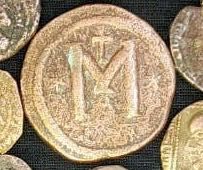Follis (large module)
Country of Origin: Byzantine Empire
Year of Issue: Circa 498-668 AD (specifically, the image likely shows a follis from the reigns of Justinian I, Justin II, or Maurice Tiberius, given the clear 'M' design)
Denomination: 40 Nummi (M)
Composition: Bronze

Brief Description
The coin prominently features a large 'M' in the center, which typically stands for 'Mille' (1000) or a specific denomination in Roman/Byzantine contexts. Above the 'M' is often a smaller symbol or cross.
Historical Significance
The follis was a large bronze coin that was introduced during the monetary reforms of Emperor Anastasius I (491-518 AD). It played a crucial role in stabilizing the Byzantine economy after a period of debasement. The large 'M' on the reverse clearly indicated its value of 40 nummi, making it easy to recognize and use in daily transactions. These coins are important for understanding the economic history and administrative changes of the early Byzantine Empire.
Estimated Value
The value can vary greatly, from $20 to $200+ depending on the specific emperor, mint, condition, and rarity. Common examples in average condition are typically in the lower range.
Care Instructions
Handle the coin by its edges to avoid transferring oils from your skin. Store it in a non-PVC coin holder or slab to protect it from environmental damage and physical scratches. Do not clean ancient bronze coins, as improper cleaning can significantly damage their patina and reduce their value.
Created At: 2025-08-12T15:07:01.499175